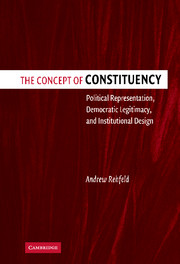 The Concept of Constituency
The Concept of Constituency Book contents
- Frontmatter
- Contents
- List of Tables
- Preface
- PART I CONCEPTUAL FOUNDATIONS: ON CONSTITUENCY AND POLITICAL REPRESENTATION
- PART II HISTORICAL JUSTIFICATIONS: ON THE ORIGINS OF TERRITORIAL CONSTITUENCIES IN THE UNITED STATES
- PART III NORMATIVE APPLICATIONS: ON LEGITIMATE REPRESENTATION AND INSTITUTIONAL DESIGN
- 7 Territory Reconsidered
- 8 Legitimate Representation and Institutional Design: For Permanent, Involuntary, Heterogeneous Constituencies
- 9 Random Constituencies
- 10 Epilogue: The Random Constituency Fifty Years from Now
- Index
8 - Legitimate Representation and Institutional Design: For Permanent, Involuntary, Heterogeneous Constituencies
Published online by Cambridge University Press: 27 July 2009
- Frontmatter
- Contents
- List of Tables
- Preface
- PART I CONCEPTUAL FOUNDATIONS: ON CONSTITUENCY AND POLITICAL REPRESENTATION
- PART II HISTORICAL JUSTIFICATIONS: ON THE ORIGINS OF TERRITORIAL CONSTITUENCIES IN THE UNITED STATES
- PART III NORMATIVE APPLICATIONS: ON LEGITIMATE REPRESENTATION AND INSTITUTIONAL DESIGN
- 7 Territory Reconsidered
- 8 Legitimate Representation and Institutional Design: For Permanent, Involuntary, Heterogeneous Constituencies
- 9 Random Constituencies
- 10 Epilogue: The Random Constituency Fifty Years from Now
- Index
Summary
INTRODUCTION
If territorial constituencies face the kinds of problems we outlined in the previous chapter, we need to ask, “what's the alternative?” In the next chapter, I will argue that randomized, national, permanent constituencies offer a promising one. Their promise rests upon the implications of some minimal aims of legitimate political representation, the subject of this chapter.
I begin the analysis by ignoring the costs of change and assume that we could redefine constituencies in any manner we wanted. If we were to build a large nation's electoral institutions from scratch, how should we think about constituency definition? Can there be a universal starting position, a baseline from which deviations must be justified? If so, what would that position be?
In this chapter, I argue that all things considered, electoral constituencies should be heterogeneous, stable, and involuntary, and they should create incentives for representatives to pursue the public good. These features form a default position derived from the limiting conditions of any plausible theory of legitimate political representation – conditions as noncontroversial as “representatives should be accountable to those they represent.” As a default position, these features of heterogeneity, stability, and involuntariness may be overridden by other more pressing values. But because they form a default position, the burden of justification will rest upon others who want homogeneous, unstable, or voluntary constituencies, including advocates of group representation or proportional systems.
- Type
- Chapter
- Information
- The Concept of ConstituencyPolitical Representation, Democratic Legitimacy, and Institutional Design, pp. 177 - 208Publisher: Cambridge University PressPrint publication year: 2005


